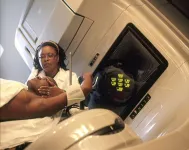(Press-News.org) Higher neighborhood density of unhealthy retail food establishments was associated with a higher risk of delivering a baby that was large-for-gestational age, according to a new study at Columbia Mailman School of Public Health, while neighborhoods with a high density of healthy food retail establishments was linked with a lower risk of giving birth to a baby that was small-for-gestational age. Babies born either small- or large-for-gestational age, a measure of birth weight adjusted for length of pregnancy, are at greater risk for long term health complications, but until now little was known about how neighborhood characteristics including walkability and the food environment, may affect birthweight outcomes. The results are published in JAMA Network Open.
To evaluate links between birth weight and retail food environments and walkability in neighborhoods of New York City the researchers analyzed the records of 106,194 singleton births in the 2015 Vital Statistics records from the NYC Department of Health and Mental Hygiene. Full-service supermarkets and fruit and vegetable markets were classified as healthy, and fast-food outlets, convenience stores, and candy stores as unhealthy.
“Our prior work has shown that these healthy and unhealthy neighborhood retail food environment classifications are associated with residents’ body mass index (BMI) in New York City,” noted Eliza Kinsey, PhD, the first author and a former post-doctoral fellow in epidemiology at Columbia Mailman School, now an assistant professor at the University of Pennsylvania.
The prevalence of babies born small for gestational age was 13 percent and the percent born large for gestational age was 8.4 percent. Residing in the most dense healthy retail food environment compared to the lowest was associated with a 11 percent lower risk of delivering a baby whose weight was low for gestational age. Conversely, compared to residing in a neighborhood with the lowest density of unhealthy retail food outlets, residing in a neighborhood with the highest density of these unhealthy food outlets was associated with a 16 to 18 percent increase in the risk of a baby being born large for gestational age. There were no significant associations between neighborhood walkability and birthweight outcomes.
“Our results further support the value of encouraging use of urban design and planning guidelines to improve food environments and ultimately healthy pregnancies and birth weight,” said Andrew Rundle, DrPH, professor of epidemiology at Columbia School of Public Health, and senior author.
The high density and low car ownership may limit the generalizability of the findings to populations outside of New York City, particularly suburban and rural areas, noted the researchers. “However, given that the percentage of the world population living in urban area is projected to grow to 68 percent by 2050, our findings for NYC are likely relevant for much of the global population,” observed Rundle.
This paper is the third part in a trilogy of research led by Dr. Rundle at Columbia Mailman School showing how built environments are linked to pregnancy and birth outcomes. The earlier papers found that higher neighborhood walkability was protective against excess gestational weight gain and against gestational diabetes.
This research was conducted in collaboration with the Bureau of Vital Statistics at the New York City Department of Health and Mental Hygiene. Co-authors are Elizabeth M. Widen, Department of Nutritional Sciences and Population Research Center, University of Texas at Austin; James W. Quinn, Columbia Mailman School; Mary Huynh and Gretchen Van Wye, New York City Department of Health and Mental Hygiene; Gina S. Lovasi, Dornsife School of Public Health, Drexel University; Kathryn M. Neckerman, Columbia University Population Research Center,; and Ellen C. Caniglia, Perelman School of Medicine, University of Pennsylvania,
The study was supported by Eunice Kennedy Shriver National Institute of Child Health and Human Development (grants R00HD101657, K01HD100222, P2CHD058486, R00HD086304, and P2CHD042849).
Columbia University Mailman School of Public Health
Founded in 1922, the Columbia University Mailman School of Public Health pursues an agenda of research, education, and service to address the critical and complex public health issues affecting New Yorkers, the nation and the world. The Columbia Mailman School is the fourth largest recipient of NIH grants among schools of public health. Its nearly 300 multi-disciplinary faculty members work in more than 100 countries around the world, addressing such issues as preventing infectious and chronic diseases, environmental health, maternal and child health, health policy, climate change and health, and public health preparedness. It is a leader in public health education with more than 1,300 graduate students from 55 nations pursuing a variety of master’s and doctoral degree programs. The Columbia Mailman School is also home to numerous world-renowned research centers, including ICAP and the Center for Infection and Immunity. For more information, please visit www.publichealth.columbia.edu
END
Unhealthy neighborhood food environments are linked to poor birth weight outcomes in New York
2023-06-12
ELSE PRESS RELEASES FROM THIS DATE:
Astronomers discover supernova explosion through rare ‘cosmic magnifying glasses’
2023-06-12
According to Einstein’s general theory of relativity, time and space are fused together in a quantity known as spacetime. The theory suggests that massive objects, like a galaxy or galaxy clusters, can cause spacetime to curve. Gravitational lensing is a rare yet observable example of Einstein’s theory in action; the mass of a large celestial body can significantly bend light as it travels through spacetime, much like a magnifying lens. When light from a more distant light source passes by this lens, scientists can use the resulting visual distortions to view objects that would otherwise be too far away and too faint to be seen.
An ...
Study brings new understanding of multiple myeloma evolution
2023-06-12
HOUSTON – A new study by researchers at The University of Texas MD Anderson Cancer Center highlights novel insights into the evolution of multiple myeloma from precursor disease, which may help better identify patients likely to progress and develop new interventions.
Published today in Cancer Cell, the study integrates paired single-cell RNA sequencing and B cell receptor sequencing from 64 patients with multiple myeloma or precursor disease. The study achieved several notable milestones in the effort to better understand ...
Previously unknown material could revolutionize cancer treatment
2023-06-12
A new material, created at the little-explored intersection of organic and inorganic chemistry, could not only enable more powerful solar panels, but it could also usher in the next generation of cancer treatments.
Described in a Nature Chemistry journal paper published today, the composite is made of ultra-tiny silicon nanoparticles, and an organic element closely related to those used in OLED televisions. It is capable of increasing the speed with which two molecules can exchange energy, and of converting lower-energy light into higher-energy light.
Only a handful of laboratories ...
19-hour days for a billion years of Earth’s history: Study
2023-06-12
It's tough accomplishing everything we want to get done in a day. But it would have been even more difficult had we lived earlier in Earth's history.
Although we take the 24-hour day for granted, in Earth's deep past, days were even shorter.
Day length was shorter because the Moon was closer. "Over time, the Moon has stolen Earth's rotational energy to boost it into a higher orbit farther from Earth," said Ross Mitchell, geophysicist at the Institute of Geology and Geophysics of the Chinese Academy of Sciences and lead author of a new study published in Nature Geoscience.
"Most models of Earth's rotation predict that day length was consistently shorter ...
New method enables study of nano-sized particles
2023-06-12
Researchers at Karolinska Institutet have created a new method of studying the smallest bioparticles in the body. The study, which is published in Nature Biotechnology, has considerable scientific potential, such as in the development of more effective vaccines.
Circulating around the body are nanoparticles that affect it in one way or another. For example, there are lipoproteins that maintain cell metabolism, pathogenic viruses that cause many diseases and lipid nanoparticles that are used to carry drugs, like recent lipid nanoparticle-based mRNA vaccines.
However, ...
Unveiling quantum gravity: New results from IceCube and Fermi data
2023-06-12
In a study published in Nature Astronomy today, a team of researchers from the University of Naples “Federico II”, the University of Wroclaw, and the University of Bergen examined a quantum-gravity model of particle propagation in which the speed of ultrarelativistic particles decreases with rising energy. This effect is expected to be extremely small, proportional to the ratio between particle energy and the Planck scale, but when observing very distant astrophysical sources, it can accumulate to observable levels. The ...
State agencies grant nationwide access to ultrasound disinfectant from Parker Labs
2023-06-12
FAIRFIELD, NJ—Parker Laboratories Inc. has announced that the environmental protection and pesticide control agencies of all 50 states have authorized registration of Tristel DUO, an intermediate-level disinfecting foam for the cleaning and disinfection of general medical surfaces—including noninvasive ultrasound transducers and their related equipment.
Tristel DUO is manufactured and distributed for US markets by Parker Laboratories under an exclusive commercial partnership with UK-based infection prevention company Tristel plc. Parker Laboratories ...
Researchers: win up to $40K studying effects of lipoprotein(a) on cardiovascular disease, stroke risk
2023-06-12
DALLAS, June 12, 2023 — The American Heart Association, the world’s leading voluntary organization focused on heart and brain health, invites scientific researchers across the globe to compete in a new data challenge to better inform the scientific understanding of how lipoprotein(a) [Lp(a)] levels impact the risk of cardiovascular disease and stroke. The winning project is eligible to receive a $40,000 USD cash prize.
High levels of Lp(a) — a low-density lipoprotein variant containing a protein called apolipoprotein(a) ...
Revolutionizing cardiology: AI-based technology offers accurate analysis of cardiac disease
2023-06-12
(Toronto, June 12, 2023) – New research published in JMIR Cardio reveals the remarkable potential of artificial intelligence (AI) technology in analyzing coronary angiography, a common diagnostic procedure for coronary artery disease. Led by Dr In Tae Moon, the study conducted at Uijeongbu Eulji University Hospital in Korea showcases the power of AI-based quantitative coronary angiography (AI-QCA) in enhancing clinical decision-making.
The study compared AI-QCA to intravascular ultrasound (IVUS), to validate its performance. IVUS is ...
Call for papers: JMIR Bioinformatics and Biotechnology
2023-06-12
JMIR Bioinformatics and Biotechnology (JBB) is a leading, international, peer-reviewed journal that aims to publish high-quality original research articles, reviews, and perspectives on all aspects of bioinformatics, computational biology, and biotechnology.
We invite researchers, educators, and practitioners to submit their original research articles, reviews, and perspectives to JBB. Our scope includes but is not limited to:
Bioinformatics, including genomic variation detection algorithms, tools, and databases
Artificial ...







